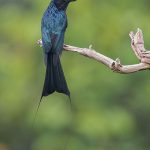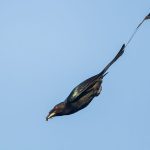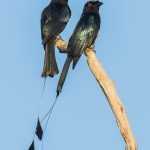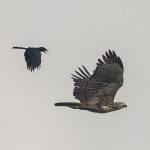The Greater Racket-tailed Drongo (Dicrurus paradiseus) is by no means a dull bird in character. In fact it is one of the liveliest bird around, with the ability to mimic and create a variety of calls and sounds. It has been suggested that it’s ability to mimic other birds, serves the function to create mix-species flocks. The purpose being to steal food (kleptoparasitism) from the member of the flock or to find insects disturbed by other foragers around.
In Singapore, they have been observed following macaques around, probably gathering food or insects disrupted by the activity of these primates. There are many other stories about this very interesting drongo, that I will leave for another time.
Today the attention is towards photography. And unfortunately for the drongo, it’s a rather neglected species photographically. Its plumage colour is a glossy bluish black. That alone is a turn-off for many photographers who would gladly choose more colourful birds. The other thing is that it has a distinctive, long outer tail shafts ending with twisted pendants. That is a very attractive feature, but is challenging composition wise to get a ‘balanced’ picture, without it being blocked or cut off.
So what are the so-called features of a good bird photo? The answers are varied and for every feature I say is good, someone is bound to disagree. But generally, a few things normally stand out.
1. Get a good, uncluttered background. Doesn’t have to be totally devoid of shape. Some like a more environmental shot with details of the habitat. But generally, despite difference in opinion as to how clean a background should be, at the very least it must not detract from the bird itself. For a forest bird, one is probably looking for a green background, or if that is unavailable, a blue sky background.
2. One of the favourite type of photos are the nesting ones with parent feeding chicks. These days there are so much controversy over this type of photography, due to overzealous photographers on one side, ‘nature policemen’ on the other, and normal photographers smack in the middle. The quest for a perfect shot and the consequences of it, has made for many a debate and lost friendship. Thankfully, I have no photos of such nature to show for the drongo, so the ‘nature policeman’ won’t cause me any grief.
3. In lieu of a good nesting shot, bird in action shots are a way to elevate the appeal of a bird. It can be anything. A bird bathing, eating, flying or even mating. Birds are not inanimate objects. Too many static shots show them as just vehicle of feathery colours, devoid of any character. One might as well be photographing a stuffed bird! It is always a challenge to show well the nature or character of the subject.
4. If all else fail, and the bird is still not interesting, try to change the subject a bit. How exactly? Let’s put it this way, if a starling is an ordinary bird, a murmuration of starlings is a beautiful subject. A pigeon is an ordinary bird, but a pigeon being pursued by a raptor is an amazing scene.
Anyway, that’s just a small list. This is an excuse for me to show you some of my Greater Racket-tailed Drongo pictures gathered so far. Gallery below.
Photo Gallery:
- With good light, the drongo’s feathers and fiery red eyes stand out nicely. The background is uncluttered and is a natural green. Most of the time, the drongo has to be photographed in portrait mode due to the length of its tail.
- As mentioned, I try to capture the bird’s character in photos. And the drongo is famous for its mimicry calls, something that it is doing here, with the bill open.
- It is very hard to show the drongo in landscape orientation. Here the lighting and the background as well as some luck enabled me to capture it in flight with an insect in mouth. The drongo is known to hawk for insects on the wing.
- If one bird doesn’t do it, sometimes a pair or more make for a more balanced composition.
- When all else fails, try to get an interesting story instead. Here in the early morning, a drongo chases away a Changeable Hawk-Eagle. They are known to be fearrless and mob larger birds. Perhaps this one is trying to defend its nest.




